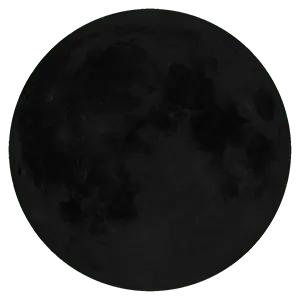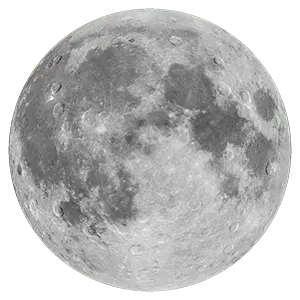The current moon phase for today and tonight is the phase. The moon is now % visible and is . Today the Moon is days old.
The approximate distance from Earth to the Moon is and days left to the next phase ().
Visit also the July 2025 Moon Phase Calendar to see all the daily moon phases for this month.
Current Time: 11.15.
Moon Phase Today:
Previous Phase:
Moon distance:
Illumination:
Moon age:
Next Phase:
Moon angle:
Sun distance:
| Moon Phase | DATE AND TIME |
DATE AND TIME (UTC) |
|---|---|---|
| New Moon | ||
| First Quarter | ||
| Full Moon | ||
| Last Quarter | ||
| New Moon |

This is the first and invisible phase of the Moon, with the illuminated side of the Moon facing the Sun and the night side facing Earth. The New Moon is only directly visible during a solar eclipse.

First Quarter
A week after new moon comes first quarter, when the Moon is a quarter of the way around its orbit. It is also termed a Half Moon. A First Quarter Moon rises around noon and sets around midnight.

Full Moon
At 100% phase illumination, the day side of the Moon is directly pointed at the night side of the Earth and the Moon is full. A Full Moon rises around sunset and sets around sunrise and it looks bigger when it is near the horizon.

Last Quarter
The Moon enters the Last Quarter (or Third Quarter) of its orbit at nearly 23 days old. Only half of it appears to be illuminated. You can see this phase at late night and in the early morning (6 am).
An analysis of moon's mineral composition suggests that the moon is around 4.425 billion years old.
More Moon FactsNo, the moon has no water and has only a very thin and tenuous atmosphere (called an exosphere) so it cannot trap heat or insulate the surface. So, for example, there is no wind to create weather system. The Moon does, in fact, affect the Earth's climate and weather patterns in several subtle ways.
More Moon FactsAn orange moon means the shorter wavelengths of light are being filtered away. This could be due to the low position on the horizon causing the light to go through more atmosphere, smoke in the air, or pollution.
More Moon FactsA supermoon occurs when the Moon's orbit is closest (perigee) to Earth at the same time the Moon is full. At such a time, the Moon can look larger and brighter than it normally does - especially when it is seen rising above the horizon. However, it's important to note that the actual difference in size and brightness between a supermoon and an average full moon is not typically dramatic, and may not be noticeable to the naked eye without a direct comparison.
More Moon FactsA "micromoon" is a term used in popular astronomy to describe a full moon or a new moon that occurs when the moon is at or near its apogee, which is the furthest point from Earth in its elliptical orbit. This is the opposite of a "supermoon," which occurs when a full moon or new moon is at or near its perigee, which is the closest point to Earth in its orbit."
More Moon FactsThe 8 moon phases in order are new moon, waxing crescent, first quarter, waxing gibbous, full moon, waning gibbous, last quarter, and waning crescent. The Moon displays these eight phases one after the other as it moves through its cycle each month. It takes 27 days for the Moon to orbit Earth. That means the Moon's cycle is 27 days long.
More Moon PhasesThe Full Moon is the fifth lunar phase. The Moon appears fully illuminated from Earth's perspective. This occurs when Earth is located between the Sun and the Moon. A Full Moon rises around sunset and sets around sunrise.
More Moon PhasesThis is the fourth phase of the Moon. The waxing gibbous phase is between a Half Moon and Full Moon and waxing means that the Moon is getting bigger and bigger. This phase of the Moon can be seen from late afternoon and most of the night (from 3 pm to 3 am).
More Moon PhasesThis is the second phase of the Moon. It occurs when the illuminated half of the Moon faces mostly away from Earth, with only a tiny portion visible to us from our planet. It grows daily as the Moon’s orbit carries the Moon’s dayside farther into view. Every day, the Moon rises a little bit later.
More Moon PhasesThis is the first and invisible phase of the Moon, with the illuminated side of the Moon facing the Sun and the night side facing the Earth.
More Moon PhasesBelievers in the lunar cycle effects on human bodies (including the hair) ascribe a similarly forceful effect of this gravitational field on the bodies of humans and animals. According to their belief system, hair grows stronger, hair care products work better, and the styling is more beautiful if the hair care regimen is scheduled according to the lunar calendar. Conditions during the waxing moon promote hair growth after a haircut. Therefore, you should cut your hair between the new and full moon if you want your hair to grow fast after a haircut.
More Fun FactsMoon dust smells like gunpowder. Just to be clear, moondust and gunpowder are not the same thing, so why is this gunpowder smell? No one really knows.
More Fun FactsIn many languages the Moon is gender neutral, in other languages it’s not. For example, in French, the Moon is feminine (la lune) and in German, the Moon is masculine (der Mond). From a cultural point of view, the Moon is often referred as feminine. For example, in Greek mythology, Selene was the Goddess of the Moon and so the Moon has been known as Selene. In Roman mythology, it was the Goddess Luna, from where we get Lunar cycles from. This would give the moon a female gender.
More Fun FactsNo one. According to international law, no one can lay territorial claim to the Moon or any other celestial body, so a national flag on the Moon is purely symbolic. There are also websites where you can buy a certificate saying you own a plot of land on the Moon, but this isn't worth the paper it is written on.
More Fun FactsAt first, Blue Moon is nothing to do with the actual color of the Moon. A Blue Moon is the second Full Moon in a calendar month. Typically, months have only one Full Moon, but sometimes a second one sneaks in. Most months are 30 or 31 days long while Full Moons are separated by 29 days, so it’s possible to fit two full moons in a single month. This happens every two and a half years, on average. Blue Moons dependent on the Gregorian calendar and time zones so you should check our Moon Calendar.
More Fun Facts